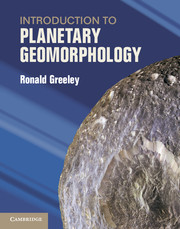Book contents
- Frontmatter
- Contents
- Foreword
- Preface
- Acknowledgments
- Chapter 1 Introduction
- Chapter 2 Planetary geomorphology methods
- Chapter 3 Planetary morphologic processes
- Chapter 4 Earth’s Moon
- Chapter 5 Mercury
- Chapter 6 Venus
- Chapter 7 Mars
- Chapter 8 The Jupiter system
- Chapter 9 The Saturn system
- Chapter 10 The Uranus and Neptune systems
- Chapter 11 Planetary geoscience future
- Appendices
- References
- Further Reading
- Index
Chapter 10 - The Uranus and Neptune systems
Published online by Cambridge University Press: 05 February 2013
- Frontmatter
- Contents
- Foreword
- Preface
- Acknowledgments
- Chapter 1 Introduction
- Chapter 2 Planetary geomorphology methods
- Chapter 3 Planetary morphologic processes
- Chapter 4 Earth’s Moon
- Chapter 5 Mercury
- Chapter 6 Venus
- Chapter 7 Mars
- Chapter 8 The Jupiter system
- Chapter 9 The Saturn system
- Chapter 10 The Uranus and Neptune systems
- Chapter 11 Planetary geoscience future
- Appendices
- References
- Further Reading
- Index
Summary
Introduction
Sir William Herschel was an amateur astronomer in Bath, England, who built his own telescopes to view stars. In March 1781 he observed a point of light that did not behave like a normal star. At first, he thought that it was a comet, but, with further observations, the object was shown to be the seventh planet – the first to be discovered in historical times. Although initially he suggested that it be named Georgium Sidus (George’s star) after the reigning King George III, it was subsequently named Uranus after the Roman god of the heavens.
Following the discovery of Uranus, Neptune’s existence was predicted before it was actually seen. Observations of the orbit of Uranus and the application of the laws of physics suggested that some object ought to exist beyond Uranus to account for its motions. On the basis of independent calculations by the British mathematician John Couch Adams and the French mathematician Le Verrier, a German astronomer, Johann Gottfried Galle, used a telescope at the Berlin Observatory to search for the proposed object. On the very first night of his search, September 23, 1846, Galle found the suspected planet within one degree of the predicted position.
- Type
- Chapter
- Information
- Introduction to Planetary Geomorphology , pp. 201 - 209Publisher: Cambridge University PressPrint publication year: 2013



